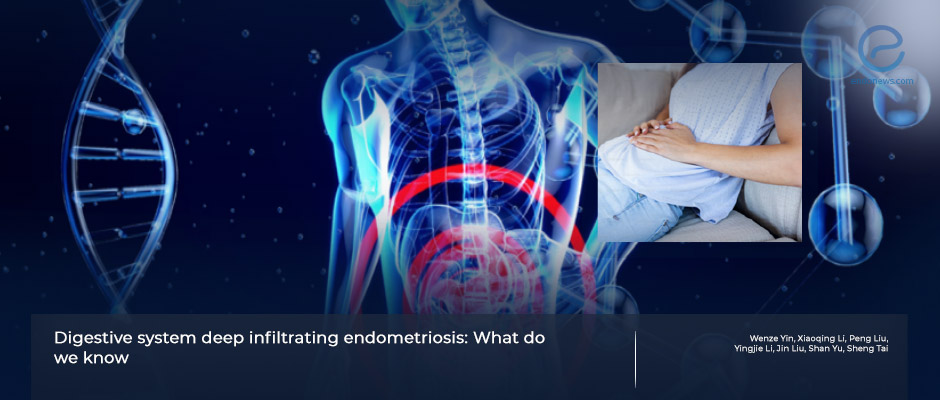A synopsis of deep infiltrating endometriosis of the digestive system
Nov 21, 2023
Review study gives comprehensive information on the pathophysiologic and genetic features of the digestive system infiltrating endometriosis
Key Points
Highlight:
- Digestive system infiltrating endometriosis (DSIE) is a complicated form of endometriosis and exhibits lymph node and vessel involvement, angiogenesis, nerve recruitment, and fibrosis.
Importance:
- Digestive system deep infiltrating endometriosis poses a diagnostic dilemma with its many similar morphological and pathogenetic features to invasive malignancies.
What’s done here:
- Researchers from China reviewed the literature on DSIE to shed light on the recent findings of its pathophysiologic and molecular mechanisms.
Key results;
- The most common location is the rectosigmoid colon.
- The regulatory T cells (Tregs) express Foxp3 and inhibit the recruitment and function of other immune cells.
- Increased IL-10 and TGF-β levels correlate with symptoms like dyspareunia and dysmenorrhea.
- Abnormal macrophage behavior contributes to fibrosis.
- Elevated iron levels and macrophage-driven oxidative stress contribute to cell damage.
- Hypoxia, hormones, cytokines, and signaling pathways regulate angiogenesis, vasculogenesis, and inosculation processes.
- The ReTIAR hypothesis involves epithelial-mesenchymal transition, fibroblast-to-myofibroblast transdifferentiation, and smooth muscle metaplasia and is linked to fibrosis.
- Cancer-associated mutations such as ARID1A, PIK3CA, PPP2R1A, and KRAS, are thought to be potentially associated with malignant transformation and fibrosis.
Lay Summary
The gastrointestinal tract is one of the most common locations of extrapelvic endometriosis. Its infiltrative counterpart exhibits more aggressive behavior and often needs to be distinguished from malignancies clinically. Yin et al. from Harbin, China reviewed the latest findings regarding the underlying pathogenetic and molecular mechanisms of the digestive system infiltrating endometriosis (DSIE). The article was published in the August 2023 issue of the Journal of Cellular and Molecular Medicine.
The most common site for digestive system infiltrating endometriosis is known to be the rectosigmoid colon with possible pathophysiological explanations such as gravity and progenitor cell transformation in the peritoneum. The immune alterations mainly involve elevated regulatory T cells (Tregs), notably expressing Foxp3, increased IL-10 and TGF-β levels, abnormal macrophage behavior contributing to fibrosis, and reduced NK cell activity in the peritoneal fluid. Elevated iron levels and macrophage-driven oxidative stress contribute to cell damage.
The presence of endometriotic cells in pelvic lymph nodes in the digestive system infiltrating endometriosis indicates lymphovascular invasion. The lymph nodes are shown to harbor immune activation characteristics and express certain chemokine receptors and proteins suggesting a potential risk of malignant transformation. It is also stated that lymphangiogenesis is prominent, driven by elevated TNF-α and IL1-β levels, with VEGF-C and VEGF-D playing crucial roles. They also exhibit significant vascularization influenced by hormonal changes. It is noted that angiogenesis, vasculogenesis, and inosculation processes are involved, and regulated by hypoxia, hormones, cytokines, and signaling pathways. Moreover, significant nerve recruitment contributes to severe deep pain with denser nerve fibers around the involved nodes. The authors also touch on fibrous tissue being a main component, differing from other endometriosis types. Fibrosis in endometriosis is linked to the ReTIAR hypothesis involving epithelial-mesenchymal transition, fibroblast-to-myofibroblast transdifferentiation, and smooth muscle metaplasia. Malignant tumor-like characteristics in this special subtype of endometriosis were also emphasized, including multifocality, multicentricity, and resemblance to digestive tract malignancies.
The authors conclude by saying that surgery remains the primary treatment and understanding of DSIE is limited. Nonsurgical methods for radical DSIE treatment and specific immunotherapeutic approaches require further research for a comprehensive understanding and effective management of this condition.
Research Source: https://pubmed.ncbi.nlm.nih.gov/37632165/
endometriosis deep gastrointestinal digestive IL1-β VEGF-C VEGF-D IL-10 Foxp3 NK ARID1A PIK3CA PPP2R1A KRAS

